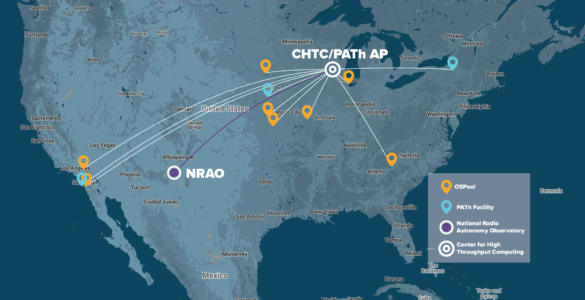Astronomers using the Very Large Array (VLA) radio telescope have found some of the best evidence to date that small, new galaxies can form from material pulled out of older galaxies. The new observations seriously weaken models of galactic evolution that attempt to explain the various types of galaxies seen in the universe as the result of different, but independent, processes. Steve Gottesman of the University of Florida in Gainesville, Tim Hawarden of the Joint Astronomy Center in Hilo, Hawaii, Caroline Simpson of Florida International University in Miami and Benjamin Malphrus of Morehead State University in Morehead, Kentucky, presented the results today to the American Astronomical Society meeting in San Antonio, TX. The astronomers used the VLA, a facility of the National Science Foundation, to study a galaxy system some 180 million light-years distant in the constellation Centaurus called NGC 5291. NGC 5291 is a peculiar spiral galaxy that appears to be interacting with a nearby object called the Seashell. The VLA observations show a large, elongated cloud of neutral hydrogen gas surrounding NGC 5291 and the Seashell.
Within that gas cloud there are several concentrations. These mostly coincide with faint “knots” which were first seen on optical photographs taken twenty years ago with the UK Schmidt Telescope in Australia for the ESO/SRC Southern Sky Survey. In a detailed study at that time, using the 4-meter Anglo-Australian Telescope (AAT) and the 65m Parkes radio telescope, the knots were shown to be giant star-forming regions and the system was found to contain an extremely large cloud of gas. Though details were lacking then, astronomers suggested that the larger knots would turn out to be galaxies either in the process of formation or recently formed from the material of the parent system.
Subsequently, similar suggestions were made about concentrations of material in the “tidal tails” ejected by galactic collisions elsewhere in the sky, but it was not possible to put the suggestions on a firm footing. This latest research, however, shows conclusively that one of the knots in the NGC 5291 system is indeed a dwarf irregular galaxy similar to the Magellanic Clouds, companion galaxies to our own Milky Way. The knot of gas, in which stars are being formed, has about 5 billion times the mass of the Sun.
“In order for it to be considered an independent galaxy, it must meet two conditions — its mass must remain gravitationally bound against its own kinetic energy and it must remain bound against the gravitational effect of the primary galaxy. This knot in the NGC 5291 system has the stable properties, the required mass, and sufficient distance from the remnant galaxies that, were it an isolated system, it would be classified as an actively star-forming dwarf irregular galaxy,” said Gottesman.
In addition, the researchers’ analysis of the VLA observations indicates that several other knots seen in the region probably are protogalaxies or young dwarf irregular galaxies in various stages of development.
“It was a great thrill to see that the VLA images resolved the hydrogen cloud into concentrations associated with the star-forming knots we studied 17 years ago, and especially rewarding to see our suspicion that some knots would turn out to be young galaxies so nicely verified,” said Hawarden, who was part of the earlier research team.
The new observations, combined with earlier evidence from interacting systems such as Arp 105 and NGC 7252, strengthen the idea that galaxy collisions must be considered an important agent of galactic evolution. “This is strong evidence that galaxies, especially in clusters where they can interact with each other and with any hot medium present in the cluster, can and do evolve in dramatic ways, including being able to form genuinely young systems,” Simpson said.
Malphrus added, “An important implication of this research is that genuinely young galaxies may evolve from the debris formed of material tidally removed by galactic interactions. We look forward to verification of this by the discovery of additional examples of genuinely young irregular galaxies in interacting systems.”
The astronomers used the VLA, a 27-antenna radio telescope west of Socorro, NM, at times when its antennas were spaced in two different configurations in order to gain both high resolving power and high sensitivity for the images. Observations of the radio spectral line of neutral hydrogen allowed the astronomers to use the Doppler shift in frequency of the received radio emissions to derive information about the velocity of the gas in different parts of the cloud.
Reduction and analysis of the data were made possible by a grant received from the National Aeronautics and Space Administration Joint Ventures in Research (NASA-JOVE) Project. Initial observations were made with the Very Large Array, an instrument of the National Radio Astronomy Observatory, a facility of the National Science Foundation operated under cooperative agreement by Associated Universities Incorporated. Digitized image and object positions were obtained using the Guide Star Astrometric Support Program developed at the Space Telescope Science Institute (STScI), which is operated by the Association of Universities for Research in Astronomy, Inc., for NASA. This research has made use of the NASA/IPAC Extragalactic Database (NED) which is operated by the Jet Propulsion Laboratory, California Institute of Technology, under contract with the National Aeronautics and Space Administration.
The National Radio Astronomy Observatory is a facility of the National Science Foundation, operated under cooperative agreement by Associated Universities, Inc.
Contact:
Dave Finley
(505) 835-7302















